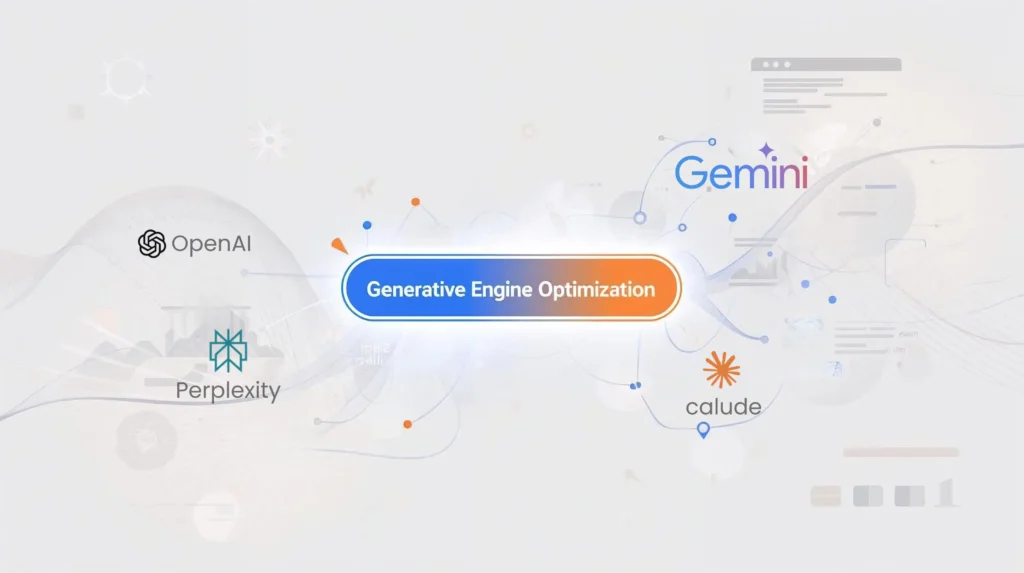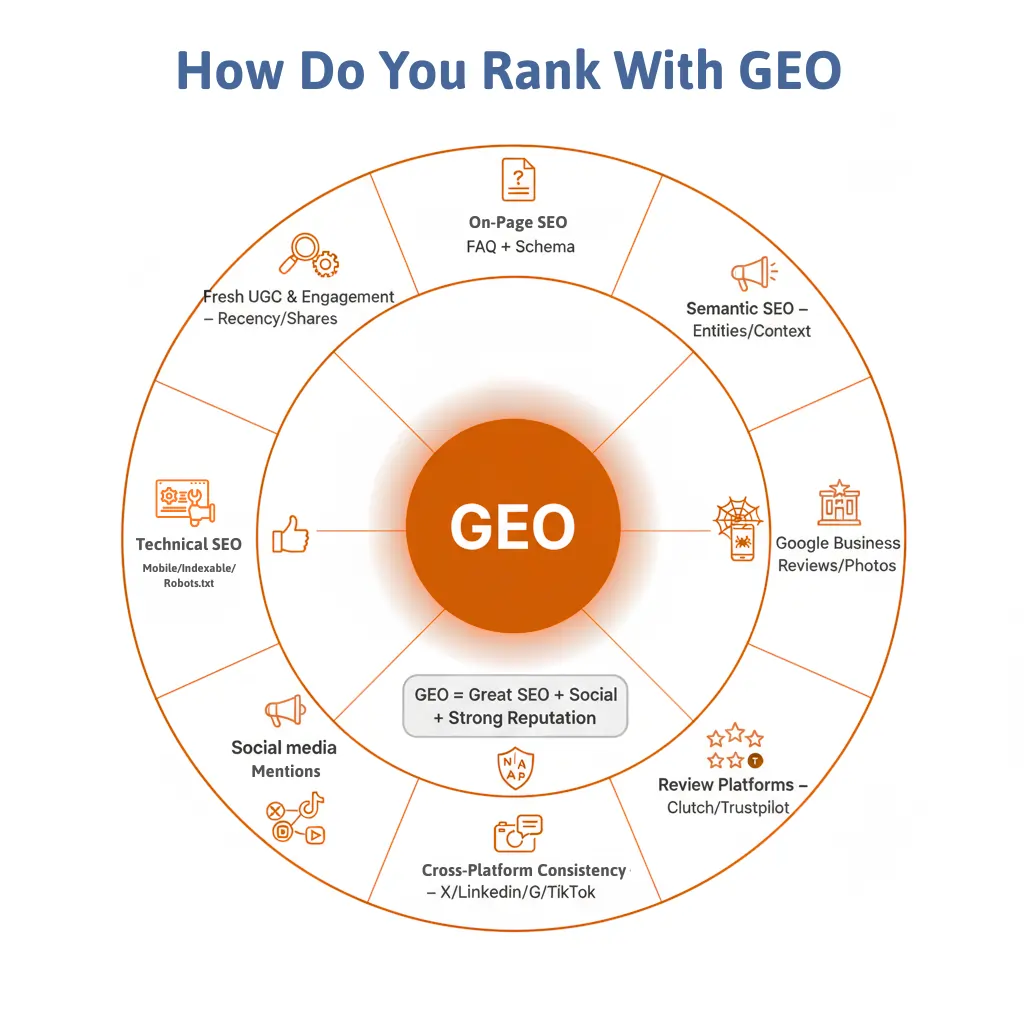What is Generative Engine Optimization (GEO) and How to Rank in AI Search?

What is Generative Engine Optimization (GEO)?
Generative Engine Optimization (GEO) is not a replacement for SEO — it’s the next step in its evolution. GEO is the process of optimizing your content so that it shows up as a cited source in answers generated by AI tools such as Google’s AI Overviews, ChatGPT, Gemini, Perplexity, and others. Instead of serving users a traditional list of “blue links,” these systems generate summarized answers and sometimes include references.
This isn’t entirely new. For more than a decade, Google has been shifting away from simple keyword matching toward AI-driven systems designed to evaluate quality and relevance. Updates like Panda (2011), RankBrain (2015), BERT (2019), SpamBrain (2018), and the Helpful Content Update (2022) all reflect this evolution. These systems use machine learning and semantic analysis to better understand context, entities (people, places, concepts), and user intent, while reducing the impact of spammy backlinks or keyword stuffing.
Today, Google and other engines use advanced AI models that build semantic embeddings — essentially, vector representations of meaning — to interpret content beyond surface-level keywords. While keywords still matter, the focus is now on semantic SEO: clarity of topic, entity relationships, and real expertise.
What makes GEO especially important now is that AI assistants and search experiences increasingly present answers directly, drawing from existing web content. As more people rely on large language models and AI overviews for research, visibility comes not only from ranking in search but also from being cited as a trusted source in these AI-generated answers. This creates a major new opportunity for Business: by producing high-quality, semantically rich, authoritative content, you can increase the chances of being featured and credited in AI-driven results — and that visibility can translate into both traffic and trust.
How to Rank in AI Search Results?
GEO = Great SEO (on-site and technical) + Social and Website Mentions + A Strong Reputation

1.Search Engine Optimization (SEO):
Strong on page seo where content is satisfying the quarry writing short sentences with built point. This means the writer should have real-world experience, be a recognized expert, and the website should be seen as a trusted source. Content written in FAQ formate includes structure data so that Ai boat can understand faster because Ai ranking factore is faster your content Ai Boat read better its ranking. Content should laser focus to the quarry.
Semantic SEO is not about repeating the same keyword but about building context. For example, when writing about New York City, you should include related landmarks and entities such as the Statue of Liberty, Central Park, and One World Trade Center. By referencing these, search engines clearly understand your content relates to New York City as an entity, not just a phrase.
2.Technical SEO:
– Ensure website is mobile-friendly (mobile-first indexing).
– Robots.txt should not block important content.
– Pages must be indexable (no accidental noindex or canonical mistakes).
– Critical content should load without requiring JS.
– Use structured content and headings hierarchy (ideally one main <h1>).
– Prevent orphan pages — all pages should be internally linked.
3. PR Posting:
Getting cited in good authoritative PR website help in brand recognition. It crete trust authority it help in GEO ranking.
4. Online Reputation Management:
Google’s AI Overviews, ChatGPT, and Perplexity are changing how clients discover businesses. Instead of just showing links, these engines summarize answers—and the sources they pull from matter. That’s where online reputation directly connects to GEO strategy.
NAP should be same across all Listing platform then only trust develop (Name, address, phone number )
Google Business Profile (GBP) is still the strongest local signal. AI systems rely on GBP for reviews, ratings, photos, and service details. A high volume of fresh, detailed reviews helps you show up.
Clutch is a trusted review platform for B2B services. Because its reviews are verified and structured.
Apple Maps & Bing Places support multi-channel discovery. Siri, in-car assistants.
Trustpilot and Glassdoor add social proof. AI often pulls review snippets and even employee sentiment when evaluating brand credibility.
Crunchbase is not a review site but provides structured company data (team, funding, milestones). These are high-authority signals that AI engines trust when generating business overviews
Reddit and Quora discussions frequently surface in generative answers because they’re real, user-driven opinions.
Yellow Pages and directories serve a background role: ensuring NAP consistency across the web, which supports both search engine trust and GEO alignment.
Why it matters for GEO: Most trending searches on LLMs are “top” or “best” (product/service). LLM chatbots rely on reviews and trusted websites to generate results, because it’s the fastest and easiest way to provide reliable answers. Getting cited on these review platforms increases your chances of being featured—and ultimately, of converting clients.
5. Social Media:
GEO needs fresh, contextual insights, and social platforms provide them by reflecting trending conversations—where high engagement through shares, comments, and mentions signals authority and influence.
Sentiment (Positive vs. Negative):
Tracking tone and emotion around your brand matters, as positive reviews, endorsements, and user-generated content (UGC) strengthen GEO visibility.
Mentions & Brand Visibility:
When your brand is organically mentioned in authentic conversations, it increases visibility while also creating more training data signals for generative engines to pick up.
Consistency Across Platforms:
Since generative engines don’t pull from just one source, maintaining a coherent, positive narrative across Twitter/X, LinkedIn, Reddit, TikTok, and Instagram reinforces both reliability and brand authority.
Generative Engine Ranking is not just about SEO, social media, or reviews — it’s an omnichannel approach. It focuses on building a complete funnel across TOFU, MOFU, and BOFU stages by leveraging every channel to rank for GEO.
Comments
Search
